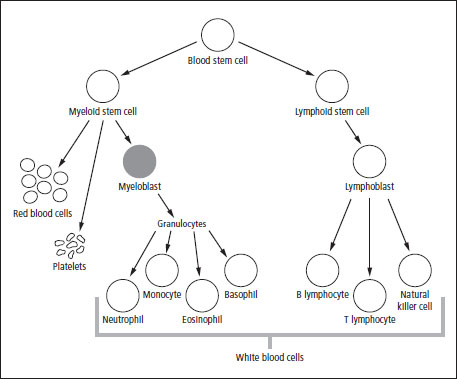Childhood Leukemia
AML Is a Blood Disease
AML is cancer of the blood cells called myeloblasts, which would normally develop into healthy WBCs (see Figure 4–1). A normal myeloid stem cell matures into one of three types of blood cells:
- Red blood cells (RBCs) that carry oxygen to all tissues of the body
- Platelets that form blood clots to stop bleeding
- WBCs that fight infection and disease
When cancerous myeloblasts appear in the bone marrow, they multiply rapidly and lose their ability to develop into mature WBCs. After accumulating in the bone marrow, cancerous myeloblasts spill over into the blood and, if left unchecked, may invade the central nervous system (CNS)—which includes the brain and spinal cord—and other organs, such as ovaries in girls or testes in boys.

Figure 4–1: AML is cancer of the myeloblasts
When leukemic blasts begin to fill the marrow, fewer normal RBCs, platelets, and WBCs are made. As the number of normal blood cells decreases, symptoms appear. Low RBC counts cause fatigue and pale skin. Low platelet counts may result in bruising and bleeding problems. If healthy WBCs are crowded out by blasts, the child will have little or no defense against infections.
My 6-year-old daughter had been getting bad headaches. The school would call me to pick her up, and she would throw up all the way home. She had an appointment with the optometrist, who noticed an odd-looking vein in her eye and that she looked pale and had some bruising. He recommended taking her in for blood work. We did, and she was diagnosed with AML.
Table of Contents
All Guides- Introduction
- 1. Diagnosis
- 2. Overview of Childhood Leukemia
- 3. Acute Lymphoblastic Leukemia
- 4. Acute Myeloid Leukemia
- 5. Juvenile Myelomonocytic Leukemia
- 6. Chronic Myelogenous Leukemia
- 7. Telling Your Child and Others
- 8. Choosing a Treatment
- 9. Coping with Procedures
- 10. Forming a Partnership with the Medical Team
- 11. Hospitalization
- 12. Central Venous Catheters
- 13. Chemotherapy and Other Medications
- 14. Common Side Effects of Treatment
- 15. Radiation Therapy
- 16. Stem Cell Transplantation
- 17. Siblings
- 18. Family and Friends
- 19. Communication and Behavior
- 20. School
- 21. Sources of Support
- 22. Nutrition
- 23. Insurance, Record-keeping, and Financial Assistance
- 24. End of Treatment and Beyond
- 25. Relapse
- 26. Death and Bereavement
- Appendix A. Blood Tests and What They Mean
- Appendix B. Resource Organizations
- Appendix C. Books, Websites, and Support Groups

